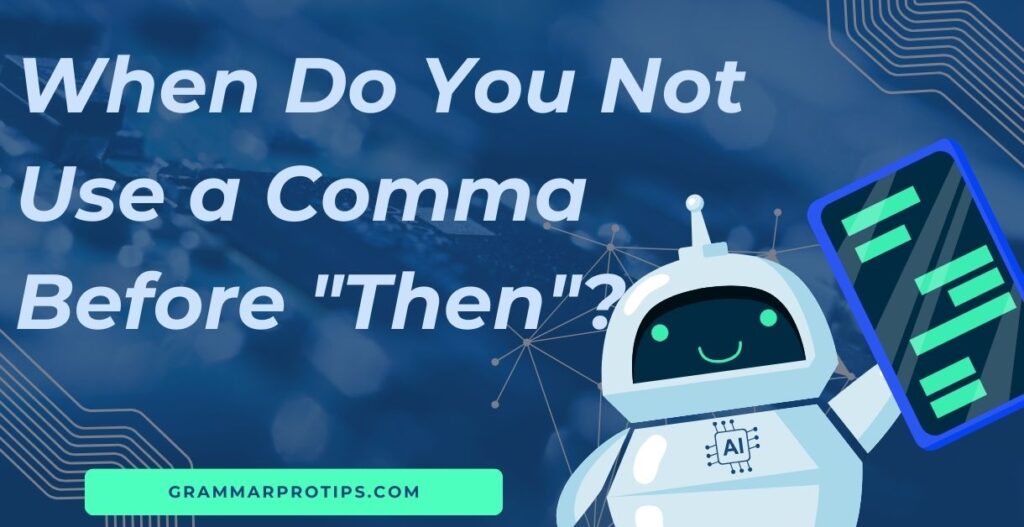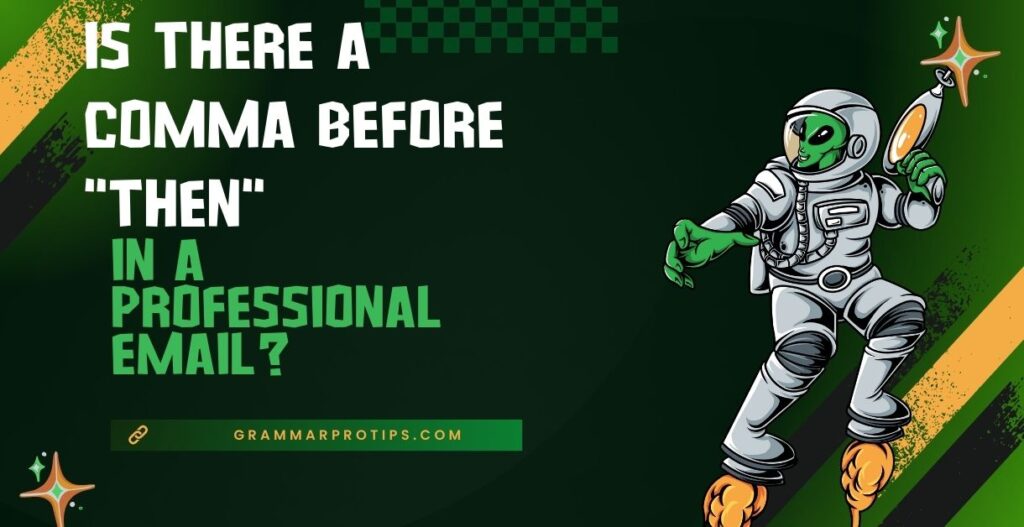When it comes to punctuation, the question of whether there is a comma before “then” often trips people up. This seemingly small detail has a surprisingly significant impact on sentence clarity and flow, especially in professional communication, casual writing, and even day-to-day email correspondence.
Understanding the Basics: What Does “Then” Do?
Before we delve into the comma question, it’s important to understand the role “then“ plays in a sentence. Typically, “then” functions as an adverb indicating time, sequence, or consequence. In other words, it helps signal the order of actions or events.
For example:
- I’ll call you, and then I’ll send the email.
- We need to finish the report first, and then we can take a break.
In both examples, “then” serves to connect two actions or events in time.
Do You Need a Comma Before “Then”?
The Short Answer: It Depends
The quick answer to “Do you need a comma before then?” is: it depends on the context of the sentence. To break this down, we need to look at the structure of the sentence and how “then” is being used.
Generally, a comma is used before “then” when:
- The sentence has two independent clauses (i.e., each part of the sentence could stand alone as a sentence).
- “Then” is used as a transition word between ideas.
- The sentence feels more natural with a pause or a slight break in the flow.
Scenarios Where You Should Use a Comma Before “Then”
1. Two Independent Clauses Connected by “Then”
When you have two independent clauses (complete thoughts) joined by “then,” a comma is typically necessary to separate them. This helps prevent run-on sentences and improves clarity. In this case, “then” acts as a coordinating conjunction linking two actions or events.
For example:
- I need to finish my presentation, and then I’ll join you for lunch.
- She’ll call the client, and then we’ll discuss the details in the meeting.
In both examples, each clause could stand alone as a sentence, so a comma before “then” is needed to show the separation between them.
2. Transitioning Between Two Thoughts or Actions
Sometimes, “then” serves as a transition word to guide the reader from one thought or action to the next. When “then” appears in the middle of a sentence as a sequence marker, a comma is often used before it to signal the pause.
For example:
- First, we need to discuss the plan, and then we can proceed with the execution.
- I’ll finish the paperwork, and then we can meet with the team.
Here, the comma before “then” allows for a clearer break between the two parts of the sentence, making the sequence of actions easier to follow.
3. Afterthought or Additional Detail
Another situation where you might see a comma before “then” is when “then” introduces an afterthought or additional piece of information at the end of the sentence. This is typically the case in more conversational writing or when you’re adding a detail after the primary action.
For example:
- I finished the report, and then, after a brief pause, I called the client.
- He’ll wrap up the meeting, and then, just to be sure, he’ll send out a summary email.
Here, the comma before “then” helps clarify the structure and prevent confusion.
When Do You Not Use a Comma Before “Then”?

While comma before “then” rules can seem straightforward, there are instances when you should not use a comma.
1. When “Then” is Part of a Simple Sentence
If “then” is used in a simple sentence or if it’s just linking two parts of a sentence that don’t need separation, you don’t need a comma.
For example:
- I’ll finish this, then I’ll call you.
- We need to finish the task then head home.
In both of these examples, the sentence doesn’t require a pause. The ideas are tightly connected, so the comma isn’t necessary.
2. When “Then” Appears in a Conditional Sentence (If-Then Structure)
In conditional sentences (if-then statements), you generally don’t need a comma before “then” unless it’s separating clauses. This is especially true when the if-clause comes before the then-clause.
For example:
- If you finish your work, then you can leave early.
- If I get the approval, then I’ll start the project.
In these cases, the sentence structure doesn’t require a pause between the two clauses, so no comma before “then” is necessary.
3. When “Then” Is Used in the Middle of a Sentence as a Sequence Marker
If “then” is used in the middle of the sentence as part of a straightforward list or a sequence, you generally won’t need a comma before it.
For example:
- We had breakfast, then we went for a walk, and then we stopped for coffee.
- He worked on the project, then he reviewed the data, and then he presented his findings.
In these examples, “then” serves to mark the order of actions, but since the sequence is flowing without interruption, no comma is necessary before “then.”
Comma Before “Then” at the End of a Sentence
The question of is there a comma before then at the end of a sentence is a bit more nuanced. Typically, you don’t need a comma at the end of a sentence before “then,” unless the comma is needed to separate the action or create a pause.
For example:
- She handed in the report, then left the office.
- We’ll finish this task, then we can head home.
In these cases, there’s no need for a comma before “then” since the sentence flows smoothly without it.
However, in more complex sentences, particularly when the afterthought punctuation comes into play, you might see a comma before “then” even at the end.
For example:
- I’ll finish my presentation, then, after a quick break, I’ll join you for lunch.
Here, the comma before “then” serves to separate the afterthought from the main idea.
Is There a Comma Before “Then” in a Professional Email?

Professional email communication often adheres to stricter guidelines when it comes to punctuation, but the rules for using a comma before “then” remain largely the same. However, clarity and readability are even more crucial when sending emails in a professional setting.
Here’s an example of how you might use commas before “then” in an email:
Subject: Next Steps in the Project
Hi Sarah,
I hope you’re doing well! I wanted to update you on the next steps. I’ll finalize the outline, and then I’ll send it over for your review. Once we have your feedback, we can begin drafting the full report.
Let me know if you have any questions.
Best regards,
John
In this email, the comma before “then” helps to separate the two actions, creating a smooth flow of ideas and making it clear when one action ends and the next begins.
Table: Quick Reference for Comma Usage Before “Then”
| Scenario | Do You Need a Comma? | Example |
|---|---|---|
| Two independent clauses linked by “then” | Yes | I’ll finish my work, and then I’ll call you. |
| Transition word introducing a new idea | Yes | I’ll finish my report, and then I’ll review the slides. |
| Sequence of events with short clauses | No | I finished the task then left the office. |
| Conditional “if-then” structure | No | If you finish your work, then you can leave early. |
| Afterthought or additional detail | Yes | I’ll finalize the document, and then, after a quick review, I’ll send it off. |
| Comma before “then” at the end of a sentence | Rarely | She handed in the report, then left the office. |
Final Thoughts on Using a Comma Before “Then”
So, is there a comma before then? As you can see, the answer depends largely on the structure and purpose of the sentence. Generally, you’ll need a comma before “then” when it separates two independent clauses, acts as a transition, or introduces an afterthought. However, you can skip the comma when “then” links actions in a simple sequence or appears in a conditional sentence.
The key takeaway is to focus on sentence clarity. If using a comma makes your sentence clearer or easier to read, go ahead and use it. If it’s unnecessary, don’t clutter your writing with extra punctuation.
Now that you understand **comma usage with

“Smith is the dedicated admin of [grammarprotips.com], a platform focused on enhancing grammar skills. With a passion for language and education, Smith strives to make grammar accessible and enjoyable for learners of all levels. Committed to delivering high-quality content, Smith continually explores innovative ways to help users master the complexities of grammar.”

